A | B | C | D | E | F | G | H | CH | I | J | K | L | M | N | O | P | Q | R | S | T | U | V | W | X | Y | Z | 0 | 1 | 2 | 3 | 4 | 5 | 6 | 7 | 8 | 9
The history of exploration by citizens or subjects of the Russian Federation, the Soviet Union, the Russian Empire, the Tsardom of Russia and other Russian predecessor states forms a significant part of the history of Russia as well as the history of the world. At 17,075,400 square kilometres (6,592,850 sq mi), Russia is the largest country in the world, covering more than a ninth of Earth's landmass. In the times of the Soviet Union and the Russian Empire, the country's share in the world's landmass reached 1/6. Most of these territories were first discovered by Russian explorers (if indigenous peoples of inhabited territories are not counted). Contiguous exploration in Eurasia and the building of overseas colonies in Russian America were some of the primary factors in Russian territorial expansion.
Apart from their discoveries in Alaska, Central Asia, Siberia, and the northern areas surrounding the North Pole, Russian explorers have made significant contributions to the exploration of the Antarctic, Arctic, and the Pacific islands, as well as deep-sea and space explorations.
Alphabetical list
- Areas primarily explored
| * Siberia/the Far East | ^ Alaska/North Pacific | ~ Europe | † Tropics |
| ‡ Arctic/the Far North | § Antarctic/South Pacific | ! Central Asia | $ Space |
A
| Portrait | Person | Achievements | Image |
|---|---|---|---|

|
Valerian Albanov‡ (1881–1919) Russian Navy lieutenant |
Albanov was one of the only two survivors of the ill-fated 1912–14 Brusilov expedition, the other being Alexander Konrad. They left the ice-bound ship St. Anna and by ski, sledge, and kayak crossed the Kara Sea, reached Franz Josef Land and were finally rescued by Georgy Sedov's Saint Phocas. The data about ice drift of St. Anna, provided by Albanov, helped Vladimir Vize to calculate the coordinates of previously unknown Vize Island.[1] Either Albanov or Konrad is a prototype for a hero in the novel The Two Captains by Veniamin Kaverin. |
 |

|
Pyotr Anjou‡ (1796–1869) Russian admiral, hero of the Battle of Navarino |
In 1820, as a lieutenant, Anjou described the coastline and the islands of Eastern Siberia between the Olenek and Indigirka rivers and mapped the New Siberian Islands. In 1825–26 he participated in describing the northeastern coast of the Caspian Sea and the western coast of the Aral Sea.[2] Named in honor: Anjou Islands. |
 |
| Danila Antsiferov* (?–1712) Siberian Cossack ataman |
Danila Antsiferov was elected Cossack ataman on Kamchatka after the death of Vladimir Atlasov. He was one of the first Russians to visit the Kuril Islands and describe them in writing, including Shumshu and Paramushir Island.[3] Named in honor: Antsiferov Island. |
 | |

|
Dmitry Anuchin† (1843–1923) geographer, anthropologist, ethnographer, archaeologist |
In 1880 Anuchin researched Valday Hills and Lake Seliger. In 1894–95, joining the expedition of Alexei Tillo, he again studied Valday. Anuchin finally determined the location of the source of the Volga River, the largest European river. He published a major work about the relief of European Russia and founded the Geography Museum at Moscow State University.[4] Named in honor: Anuchin crater (Moon), Anuchin Island. |
 |

|
Vladimir Arsenyev* (1872–1930) military topographer, writer |
Arsenyev wrote a number of popular books about his journeys to the Ussuri basin in 1902–07, where he was accompanied by Dersu Uzala, a native Nanai hunter. Arsenyev was the first to describe numerous species of Siberian flora; he produced some 60 works on the geography, wildlife and ethnography of the regions he traveled to. In 1975, the joint Japanese-Soviet movie Dersu Uzala by Akira Kurosawa won an Academy Award for the Best Foreign Language Film.[5] Named in honor: Arsenyev (town). |
 |

|
Vladimir Atlasov* (1661/64–1711) Siberian Cossack ataman |
Atlasov established the first permanent Russian settlements on Kamchatka Peninsula and led its colonisation. He was the first to present a detailed description of the region's nature and people, and also accounted on the lands near Kamchatka – Chukotka and Japan. Atlasov brought Dembei, a shipwrecked Japanese merchant, to Moscow, where he conducted the first Japanese language education in Russia.[6] Named in honor: Atlasov Island, Atlasov volcano. |
 |
B
| Portrait | Person | Achievements | Image |
|---|---|---|---|

|
Mikhail Babushkin‡ (1893–1938) military and polar aviator, Hero of the Soviet Union |
Babushkin took part in an expedition to rescue Umberto Nobile in 1928, and in the rescue of the SS Chelyuskin crew in 1933. He performed the flights to the first drifting ice station North Pole-1 in 1937. In 1937–38 he participated in a search for Sigizmund Levanevsky.[3] Named in honor: Babushkinsky District (Moscow), Babushkinskaya (Moscow Metro). |
 |

|
Konstantin Badygin‡ (1910–1984) Soviet Navy captain, writer, scientist, Hero of the USSR (Badygin left, Sedov's mechanic D.G. Trofimov right) |
In 1938 Badygin became the captain of the ice-captured icebreaker Sedov, turned into a kind of drifting ice station. Most of the crew was evacuated, but 15 sailors and scientists, including Vladimir Vize, stayed aboard and carried out valuable scientific research in the course of 812 days. After drifting from New Siberian Islands across the North Pole, they were finally freed between Greenland and Svalbard by icebreaker Joseph Stalin in 1940.[7] |  |

|
Karl Ernst von Baer* (1792–1876) naturalist, a founder of embryology |
In 1830–40 Baer researched Arctic meteorology. He was interested in the northern part of Russia and explored Novaya Zemlya in 1837 collecting specimens. Other travels led him to the Caspian Sea, Lapland, and North Cape, Norway. After his explorations of the Volga River he formulated the geological Baer's law, stating that in the Northern Hemisphere erosion occurs mostly on the right banks of rivers, and in the Southern Hemisphere on the left banks. Baer was one of the founders of the Russian Geographical Society in 1845, and also a co-founder and the first President of the Russian Entomological Society.[4] |  |

|
Georgiy Baidukov‡ (1904–1994) military and test pilot, Hero of the Soviet Union (Baidukov, Chkalov and Belyakov in 1937) |
Baidukov was involved in a number of Soviet ultralong flights. In 1936 Valery Chkalov, Baidukov and A.V.Belyakov on ANT-25 flew 9,374 km from Moscow through the North Pole to follow-up Chkalov Island in Okhotsk Sea, which took 56 h 20 min. In 1937, also on ANT-25, the same crew flew 8,504 km from Moscow through the North Pole to Vancouver, Washington, which was the first transpolar flight between Europe and North America by airplane, rather than dirigible.[8] Named in honor: Baydukov Island. |
 |

|
Alexander Baranov^ (1746–1819) merchant, colonial administrator |
Baranov was hired to head the Shelikhov-Golikov Company, which in 1799 was transformed into the Russian-American Company. Thus Baranov became the first governor of Russian America and held this post in 1799–1818. He explored the coast areas of northwestern North America, helped Russian Orthodox missionaries and improved relations with Alaska natives. He established trade with China, Hawaii and also with California, where he founded Fort Ross.[9] Named in honor: Baranof Island. |
 |

|
Nikifor Begichev‡ (1874–1927) Russian Navy officer (forensic facial reconstruction) |
Begichev was the bosun of the ship Zarya, carrying Eduard Toll's expedition in 1900–03. In 1922, at the request of Norway, Begichev led a Soviet expedition in search of the lost crew members of Roald Amundsen's 1918 expedition on the ship Maud, Peter Tessem and Paul Knutsen, but was unsuccessful (remains were later found by Georgy Rybin). In 1923–24 Begichev explored the Taymyr Peninsula with Nikolay Urvantsev.[10][11] Named in honor: Bolshoy Begichev Island, Maliy Begichev Island. |
 |
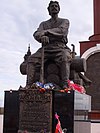
|
Pyotr Beketov* (c. 1600–c. 1661) Siberian Cossack voevoda (a monument in Chita, Zabaykalsky Krai) |
Beketov, initially a strelets, was appointed Enisei voevoda in Siberia after 1627. He successfully carried out the voyage to collect taxes from Zabaykalye Buryats, becoming the first Russian to set foot in Buryatia. He founded the first Russian settlement there, Rybinsky ostrog. Beketov was sent to the Lena River in 1631, where in 1632 he founded Yakutsk, a startpoint of further Russian expeditions eastward, southward and northward. He sent his Cossacks to explore the Aldan and Kolyma rivers, to found new fortresses, and to collect taxes. In 1652 he launched another voyage to Buryatia, and in 1653 Beketov's Cossacks founded follow-up Chita and then future Nerchinsk in 1654.[12] |  |

|
Alexander Bekovich-Cherkassky! (?–1717) Russian Army officer |
Bekovich-Cherkassky, a Circassian Muslim converted to Christianity, was made by Tsar Peter the Great the leader of the first Russian military expeditions into Central Asia in 1714–17, with the aim of conquering the Khanate of Khiva and the golden sands of the Oxus River. Bekovich received these orders in Astrakhan, where he was engaged in preparing the first Russian map of the Caspian Sea. He commanded a preliminary expedition to Turkmenistan and set up the forts in Krasnovodsk and Alexandrovsk. In 1717 he won the battle against Khivan Khan, but was tricked into separating his men, betrayed by the Khan, defeated and killed.[13] |  |

|
Fabian Gottlieb von Bellingshausen§ (1778–1852) Russian admiral, circumnavigator, cartographer |
Bellingshausen took part in the first Russian circumnavigation under Ivan Krusenstern on Nadezhda in 1803–06. He himself led another Russian circumnavigation in 1819–21 on the sloop Vostok, together with Mikhail Lazarev on Mirny – this expedition was the first to discover the continent of Antarctica on January 28, 1820 (New Style). They also discovered and named Peter I Island, Zavodovski, Leskov and Visokoi Islands, Antarctic peninsula mainland and Alexander Island (Alexander Coast), and made discoveries in the tropical waters of the Pacific, including Vostok Island.[14][15] Named in honor: Bellingshausen Island (Atlantic), Bellingshausen Sea, Bellingshausen Station, Bellinshausen Island (Pacific), Faddey Islands, Bellingshausen Plate, Bellinsgauzen crater (Moon), 3659 Bellingshausen (minor planet). |
 |

|
Lev Berg! (1876–1950) geographer, biologist |
Berg studied and determined the depth of the lakes of Central Asia, including Balkhash Lake and Issyk Kul. He researched the ichthyology of Central Asia and European Russia. He developed Dokuchaev's doctrine of biomes and climatology and was one of the founders of the Geographical Institute, now the Faculty of Geography of the Saint Petersburg University. In 1940–50 Berg was the President of the Soviet Geographical Society.[16] |  |

|
Vitus Bering^ (1681–1741) Russian Navy captain-commander |
Returning from the East Indies, Bering joined the Russian Navy in 1703. He became the main organiser of the Great Northern Expedition to explore northern Asia. In 1725, Bering went overland to Okhotsk, crossed to Kamchatka, and aboard Sv. Gavriil mapped some 3500 km of the Bering Sea coast and passed the Bering Strait in 1728–29. Later, Ivan Fyodorov and Mikhail Gvozdev aboard the same Sv. Gavriil sighted the Alaskan shore in 1732. Having organised a major Second Kamchatka expedition, Bering and Aleksei Chirikov sailed from Okhotsk in 1740 aboard Sv. Piotr and Sv. Pavel, founded Petropavlovsk-Kamchatsky, and headed together to North America in 1741, until separated by storm. Bering discovered the southern coast of Alaska, landed near Kayak Island and discovered the Aleutian Islands. Chirikov discovered the shores of America near Aleksander Archipelago and safely returned to Asia. Bering, however, became very ill and his ship was driven to an uninhabited follow-up Bering Island of the Commander group. Bering died there, along with part of his crew. The rest built a vessel out of the wreckage of Sv. Piotr and escaped to Petropavlovsk.[17][18][19] Named in honor: Bering Strait, Bering Sea, Bering Island, Bering Glacier, Bering Land Bridge, Beringia. |
  |

|
Yuri Bilibin‡ (1901–1952) geologist |
Bilibin led the First Kolyma Expedition in 1928 and in 1931–1932 he organized the Second Kolyma Expedition. The result of the explorations was the discovery of gold deposits in Northeast Siberia. In 1934, together with mining engineer Evgeny Bobin (1897–1941), Bilibin surveyed and charted the last unmapped areas of the continental USSR, the Yudoma-Maya and the Aldan highlands, as well as the Sette-Daban, in the course of an expedition sent by the Soviet government.[20] Named in honor: Bilibino Town, Bilibino District, Bilibinskite. |
 |
| Joseph Billings^ (c. 1758–1806) Royal Navy and Russian Navy officer |
In 1785–95 Billings, previously an English officer who had sailed with Captain Cook, led a Russian expedition in search of the Northeast Passage, with Gavril Sarychev as his deputy. They made accurate maps of the Chukchi Peninsula, the west coast of Alaska, and the Aleutian Islands. They landed on Kodiak Island, examined the area of Prince William Sound and compiled a census of the native population of the Aleutians. Billings crossed Chukotka on reindeer and made the first elaborate description of the Chukchi people.[21] Named in honor: Cape Billings, Billings (Chukotka). |
 | |

|
Georgy Brusilov^ (1884–1914?) Russian Navy captain |
In 1910–11, Brusilov took part in a hydrographic expedition on the icebreakers Taymyr and Vaygach to the Chukchi and East Siberian Seas. In 1912–14 he led an expedition on the brig St.Anna, which aimed to travel by the Northern Sea Route from the Atlantic to the Pacific. St.Anna became icebound west of Yamal Peninsula and drifted to the North Pole in 1913. Brusilov became ill and many of the crew succumbed to scurvy. In 1914 a group led by lieutenant Valerian Albanov abandoned the ship and walked south over the drifting ice. Only Albanov and Alexander Konrad managed to reach Franz Joseph Land, where they were rescued by Georgy Sedov's St. Foka. The efforts to find the St. Anna were unsuccessful.[1] Brusilov and his ship are among the prototypes for the novel The Two Captains by Veniamin Kaverin, where the fictional St. Maria repeats the drift of St. Anna. |
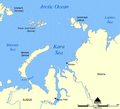 |

|
Alexander Bulatovich† (1870–1919) Russian Army officer, writer, hieromonk (tonsured Father Antony), imiaslavie leader, hero of World War I |
In 1897 Bulatovich was a member of the Russian mission of the Red Cross in Africa, where he became a confidant of Negus Menelek II of Ethiopia and his military aide in the war with Italy and the southern tribes. He became the first European to provide a description of the Kaffa province (conquered by Menelek II with Bulatovich's help) and among the first to reach the mouth of the Omo River. Among the places named by Bulatovich was the Nicholas II Mountain range.[22][23] The prototype for grotesque Schema-Hussar Alexei Bulanovich in Ilf and Petrov's The Twelve Chairs; the hero of Valentin Pikul's The Hussar on a Camel and Richard Seltzer's The Name of Hero. |
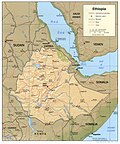 |

|
Fabian Bellingshausen† (1878–1852) Russian officer of Baltic German descent in the Imperial Russian Navy, cartographer and explorer |
The discoverer of the Antarctica.
In 1819 the authorities selected Bellingshausen to lead the First Russian Antarctic Expedition which was intended to explore the Southern Ocean and to find land in the proximity of the South Pole. With two ships, sloop-of-war Vostok ("East") and support vessel Mirny ("Peaceful") were led by Mikhail Lazarev, the journey started from Kronstadt on 4 June 1819. Bellingshausen and Lazarev managed to twice circumnavigate the continent. Thus they disproved Captain Cook's assertion that it was impossible to find land in the southern ice fields. The expedition also made discoveries and observations in the tropical waters of the Pacific Ocean. |
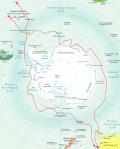 |
C
| Portrait | Person | Achievements | Image |
|---|---|---|---|

|
Semion Chelyuskin‡ (c. 1700–1764) Russian Navy officer (Malygin, D. Ovtsyn, Chelyuskin, Kh. Laptev and D. Laptev on a commemorative coin) |
Chelyuskin participated in the Great Northern Expedition in 1733–43. He traveled in the groups led by Vasily Pronchischev and Khariton Laptev. In 1741 he led his own voyage from the Khatanga River to the Pyasina River by land. He explored and described the western coastline of Taimyr Peninsula and the mouths of Pyasina and Yenisei Rivers. In 1741–42, he traveled from Turukhansk to the mouth of the Khatanga and described the northern coastline of Taimyr from Cape Faddey in the east to the mouth of the Taimyra River in the west. Chelyuskin discovered the northern extremity of Asia, Cape Chelyuskin.[24] Named in honor: Cape Chelyuskin, Chelyuskin Peninsula, Chelyuskin Island, Chelyuskin steamship. |
 |

|
Ivan Chersky* (1845–1892) paleontologist, geologist, geographer |
Exiled to Transbaikalia for participation in the January Uprising and pardoned only in 1883, Chersky became a self-taught scientist in Siberia. He traveled to the Sayan Mountains, the Irkut River Valley and Lower Tunguska. During four expeditions in 1877–81 Chersky explored Selenga river. He explained the origin of Lake Baikal, made the first geological map of its coast and described the geological structure of East Siberia. He analysed the tectonics of Inner Asia and pioneered the geomorphological evolution theory. He collected over 2,500 ancient bones. In 1892 he explored the Kolyma, Yana and Indigirka Rivers and died from illness there.[25] Named in honor: Chersky Range, Chersky (settlement). |
 |

|
Vasili Chichagov‡ (1726–1809) Russian admiral, victorious commander-in-chief of the Baltic Fleet in the Russo-Swedish War (1788–1790) |
In 1764–66 Chichagov led two expeditions to find the Northeast Passage between the Atlantic and the Pacific along the northern coast of Siberia, a project of Mikhail Lomonosov. Although he sailed past Svalbard, reached 80°26'N in 1765 and 80°30'N in 1766, and conducted valuable research, both expeditions failed to find the route.[26] Named in honor: Chichagof Island. |
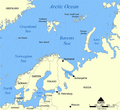 |

|
Pyotr Chikhachyov! (1808–1890) naturalist, geologist |
In 1842 Chikhachyov led an expedition to the unknown territories of the Altai and Sayan Mountains. He discovered Kuznetsk Coal Basin, reached the sources of the rivers Abakan, Chu and Chulyshman, and entered Tuva. In 1845 he published works on the geology of Altai Mountains and Xinjiang. In 1848–63 he led eight expeditions in Asia Minor, Armenia, Kurdistan and East Thrace. In 1853–69 he conducted a major study of Asia Minor, while being the attaché of the Russian embassy in Constantinople. In 1878, at the age of 71, he visited Algeria and Tunis. He published many works in geography, natural history and the politics of the Eastern Question.[27] |   |

|
Artur Chilingarov‡ (born 1939) polar scientist, Hero of the Soviet Union, Hero of Russia, politician |
In 1969 Chilingarov became the head of the research station "North Pole-19" and in 1971 the head of Bellingshausen Station during the 17-th Soviet Antarctic Expedition. In 1985 he successfully led the mission to rescue the research vessel Mikhail Somov, which had been ice-blocked in the Southern Ocean. During the Russian Arktika 2007 expedition, Chilingarov, accompanied by other explorers from different countries, descended to the seabed 13,980 feet below the North Pole in order to plant the Russian flag there and gather specimens of the bottom ground, using MIR submersibles. In 2008 he took part in the expedition which descended one mile to the bottom of Lake Baikal on MIRs.[28] |  |

|
Aleksei Chirikov^ (1703–1748) Russian Navy captain |
In 1725–30 and in 1733–43, Chirikov was Vitus Bering's deputy during the 1st and the 2nd Kamchatka expeditions. On July 15, 1741, Chirikov, the captain of Sv. Pavel, became the first European to land on the northwestern coast of North America near Alexander Archipelago. Thereafter he discovered some of the Aleutian Islands. In 1742 Chirikov specified the location of the Attu Island during the search for Bering's lost ship. In 1746 Chirikov took part in creating the final map of the Russian discoveries in the northern Pacific Ocean.[29] Named in honor: Chirikof Island. |
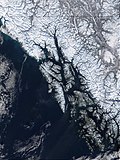 |

|
Valery Chkalov‡ (1904–1938) military and test pilot, Hero of the Soviet Union |
Chkalov developed several new figures of aerobatics. He was involved in a number of Soviet ultralong flights. In 1936 Chkalov, Georgiy Baidukov and A.V.Belyakov on ANT-25 flew 9,374 km from Moscow through the North Pole to follow-up Chkalov Island in the Okhotsk Sea, which took 56 h 20 min. In 1937, also on ANT-25, the same crew flew 8,504 km from Moscow through the North Pole to Vancouver, Washington, which was the first transpolar flight between Europe and North America on airplane, rather than on dirigible.[30] Named in honor: Chkalovsk; Chkalov Island, Chkalovskaya (Moscow Metro), Chkalovskaya (Saint Petersburg Metro). |
 |
D
| Portrait | Person | Achievements | Image |
|---|---|---|---|

|
Semyon Dezhnyov^ (c. 1605–1672) Siberian Cossack leader |
In 1643 Dezhnyov and Mikhail Stadukhin discovered the Kolyma River and founded Srednekolymsk. Fedot Alekseyev Popov organized a further expedition eastward, and Dezhnyov became a captain of one koch. In 1648 they sailed from Srednekolymsk down to the Arctic and after some time they rounded a 'great rocky projection', thus becoming the first to pass through the Bering Strait and to discover Chukchi Peninsula and the Bering Sea. All their kochi and most of their men (including Popov himself) were lost in storms and clashes with the natives. A small group led by Dezhnyov reached the mouth of the Anadyr River and sailed up it in 1649, having built new boats out of the wreckage. They founded Anadyrsk and were stranded there, until Stadukhin found them, coming from Kolyma by land.[31] Named in honor: Cape Dezhnyov (the easternmost cape of Eurasia). |
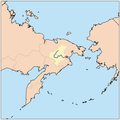 |

|
Vasily Dokuchaev~ (1846–1903) geographer, geologist, pedologist |
Dokuchaev led numerous expeditions to study the soils and geology of European Russia. As a result of his long research of Russian soils, he founded modern soil science, developed the conception of biomes and proposed ways to improve soil productivity.[2] Named in honor: Dokuchaevsk. |
 |
E
| Portrait | Person | Achievements | Image |
|---|---|---|---|

|
Arvid Adolf Etholén^ (1799–1876) Russian Navy officer, colonial administrator |
Etolin sailed to Alaska with Vasily Golovnin on Kamchatka and entered the service of the Russian-American Company. He was part of a group that surveyed the Aleutian Islands in 1822–24. In 1833 he explored the Gulf of Alaska. Etolin was the governor of Russian America in 1840–45, and continued to explore Alaska and the Bering Sea.[32] Named in honor: Etolin Island, Etolin Strait. |
 |

|
Eduard Eversmann! (1794–1860) naturalist |
In 1820 Eversmann traveled to Bukhara disguised as a merchant and in 1825 traveled with a military expedition to Khiva. In 1828 he became a professor of zoology and botany at the University of Kazan. He wrote numerous publications and pioneered the research of the flora and fauna of the southeast steppes of Russia between the Volga and the Urals.[33] Named in honor: Eversmann's redstart, Eversmann's parnassian, Eversmann's rustic and other species. |
 |
F
| Portrait | Person | Achievements | Image |
|---|---|---|---|

|
Alexei Fedchenko! (1844–1873) naturalist |
Zdroj:https://en.wikipedia.org?pojem=List_of_Russian_explorers























